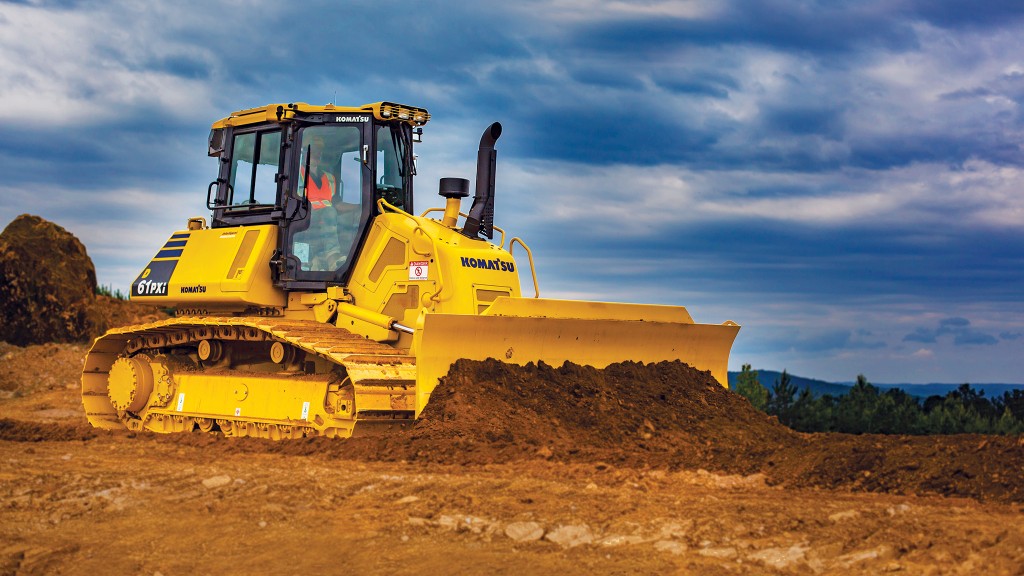
No one could have predicted the changes to work that we've seen in 2020 – including on construction jobsites. While the adoption of technology for remote monitoring and service of construction equipment had been steadily growing, the pandemic has made remote service and support even more integral to construction operations. We talked to two Canadian dealers about the support they provide their customers during the pandemic and the role that remote service plays in keeping everyone safe.
SMS Equipment
When March of 2020 rolled around, the sudden onset of pandemic protocols across the country caught SMS Equipment by surprise as it did with just about everyone else.
The difference, though, was that as the world started to go virtual around them, SMS was – in many ways – already there.
As a dealer for Komatsu, with its SMART Construction philosophy and product lines, SMS had a team of technology experts ready to deploy their remote service and monitoring capabilities for construction contractors across Canada once COVID had impacted regular business functions.
"The increase in demand during COVID from a technology point of view has just skyrocketed – just as everybody else has done with Zoom and all these other platforms, it's been no different on construction sites," said Jacen Cowick, SMS manager of SMART Construction. "We have to be very cautious about cross-contamination, very cautious about travel. Servicing our customers and some construction sites was very much of a challenge, where restrictions were very high and with the social distancing aspect. One of my biggest challenges was keeping my own people safe – and not just my people, but the customer as well."
As lockdowns fell into place across Canada with varying levels of strictness, machine owners found themselves in a difficult spot: many suddenly were left without access to dealership support for maintenance and service – at least without significantly increasing safety precautions that varied greatly from location to location. That, according to SMS, led to a very distinct increase in interest when it came to remote options.
"It was instant in March – when the whole country kind of shut down at once. . . all of a sudden people couldn't leave their offices and they were thinking ‘Okay, now I'm in front of a computer. What can I do from here so I'm not getting behind in my job? How do I keep moving forward?'" said Lacey McKay, SMS telematics lead. "I think everything slowed down for a little while, which gave people the opportunity to take a closer look at what they could do within these systems. Telematics all of a sudden took a higher priority. . . people had this tool at their disposal but not necessarily the time to dive deep on how to utilize them. Customers were now requesting training to help better understand the overall information.
While the sudden onset of lockdown and the need for remote work was a shock to everyone, SMS was able to navigate it quickly – because it already had much of the capacity to jump right in and get going. Technology was part of the company's offerings already, and as the country started to shut down it was able to answer the call of customer demand quickly.
"Prior to COVID we did online training and remote support - we had the infrastructure in place to support it. What we didn't realize is how much the demand would increase," Cowick said. "We were able to adapt quickly and with limited confusion or stress for both the customer and our organization."
The volume of remote work and data increased significantly, but that was easily handled by the team overall, Cowick said. For McKay, the onrush of interest in more telematics and remote work options was an opportunity to show what her team could do.
"We were able to kick it into high gear and help those customers out to the best of our ability," she described. "That's the amazing thing about telematics – those systems are structured to be remote. We made sure we had a plan in place to get information efficiently, and we were able to prove that we were going the right direction – we were able to meet and exceed the demand of the customers."
While shutdowns meant that there was less opportunity for technicians to get to machines on jobsites, the introduction of new tools has helped expand the ability for SMS teams to work with their customers remotely. Cowick pointed to software updates like SMART Construction Remote that allows teams to log in to machines from the office to do a variety of tasks.
"The demand for remote access has increased. . . transferring files and troubleshooting machines – the need and the speed are there, and the desire is there," Cowick said. "There's a ton of different types of technology out there. We have integrated machines and we have aftermarket technology. . . what we've noticed is that during COVID the integrated machines have been easier to support, which means less downtime for the customer. Customers are starting to see the value in the integrated machines – the value of what that extra speed and time is able to do for them in limiting their downtime."
McKay said that her team has found there's additional demand for training from customers who are trying to understand telematics systems and solutions more broadly.
"Some customers have taken advantage of our ability to do online webinars. We set scheduled timeframes and give customers the ability to log on and learn about some of the systems for their equipment," she said. "We talked in-depth about some things, and others we covered generally to give customers the basics."
In addition, the SMS team – which has expanded to deal with greater demand, McKay noted – has offered phone support and the opportunity to do one-on-one personalized training for customers, she added. Customers are also turning to more alerts from their telematics systems to keep up on what their machines require.
"We have the capabilities to set up in our systems to email the customers at their requested time prior to maintenance being required. . . people have been asking for a lot longer lead time for maintenance notifications," she said. "You now need to get approvals for people to be onsite. . . the availability of supplies may be lower, so it may take an extra day or two to get filters, for example. Customers want the ability to have that time cushion and are making sure they're pre-planning more than they ever have before."
For George Latif, an SMS machine control specialist based in Quebec, the lockdown challenge has been even greater because of the way in which Quebec clamped down hard on jobsites through the early parts of the pandemic.
"In March when they announced we were going to lock down, all of Quebec literally went on a complete pause – nothing was moving anymore," he said. "We were still available, but we couldn't travel. . . even if I could get to the customer I would need them to supply me a letter from the government saying this was an essential service."
For Latif and his customers, Komatsu's Remote Support technology was the lifeline that kept things moving. When he needed to work with any integrated machines, they were accessible right at his fingertips as long as they were in an area with cellular service. With that connection he was able to connect to a machine and upload or transfer files where necessary, as well as receive reports from the machine regarding its condition and send communications to the operators as needed.
"Remote support was always part of our job, because some machines may be a five, six, seven hour drive away. . . remote support was already helping us. But, with COVID, it's even more so," Latif said. "For example, I had a machine that was delivered last week but it was in the red zone. . . I helped the mechanics in the branch calibrate the machine with the remote support, they delivered the machine for our customers and I gave the training for that machine through remote support."
That kind of support has attracted attention in many regions, some of which can be slower to adopt new technology. SMS has seen growth in demand for remote support, and McKay expects to see that continue.
"I think this gave people a taste of how businesses should be using these tools," she said. "This is not something that's just going to go away at the drop of a hat next week. It opens the door for people to start looking at other avenues, making that time for dedicated training and recognizing that these systems are important from the top down of their business."
Finning Canada
At the start of the pandemic, Finning Canada responded by providing the resources for customers to collaborate in modifying their fleet maintenance protocols to address COVID-19 safety protocols, ensuring that the long-term health of their assets would not be impacted.
As western Canada's dealer for Caterpillar equipment, Finning already had a strong remote service program for customers, managing over 25,000 customer-owned connected assets, with 8,000 of those assets subscribed to condition monitoring services.
According to James Morrison, director, Performance Solutions Operations, Finning Canada, the condition monitoring team looks at the data on those assets to make mechanical recommendations and detect failures before they happen. These go-to tools enable Finning to provide reliable, data-driven troubleshooting that keeps customers and technicians safe during the pandemic.
"As part of our service excellence process, we also have a digital status check to ensure we are using all the data and tools at our disposal, including remote services, to maximize uptime for our customers," said Morrison. "The digital check improves the effectiveness and quality of our response as we have more insight into the actual problem – and are better prepared for all possible repair scenarios before a technician is even dispatched."
The digital status check also gives Finning the insight to prioritize critical repairs and assess non-essential repairs that can be delayed.
"When COVID-19 started, access to sites and equipment was limited, but we were able to use remote services to support our customers and provide them with the confidence their equipment would be ready to go when they needed it," said Morrison. "Yes, we had to change the way we did business, but the data gave us the confidence we were not compromising customer service or the long-term health of equipment."
Leveraging data to support customers in their long-term planning is a key part of Finning's approach to customer service. With VisionLink telematics, Finning and its customers can review machine utilization and asset location, and Finning can provide its customers with a supply chain forecast that outlines where customers should allocate resources.
Like using proper PPE, wearing a seatbelt and maintaining jobsite awareness, following COVID-19 safety protocols is now an integral part of the job for every person who is an essential worker on a jobsite – and like so many other jobs in 2020, reducing in-person interaction where possible is key.
"This is not just about asset health. It is also about the health and safety of our technicians and customers. Remote monitoring has allowed us to reduce unnecessary call outs, while maintaining the customer's confidence in our ability to support their business, even during a pandemic," said Morrison.
He expects use of remote services technology will continue to grow – in both features and adoption. The use of remote service allows Finning and customers to be fully prepared for the repair before the technician steps on to the jobsite, and eliminates unnecessary service calls which, Morrison noted, optimizes every dollar a customer invests in services.
Company info
16901 - 109 Avenue
Edmonton, AB
CA, T5P 4P6
Website:
finning.com
Phone number:
888-346-6464




